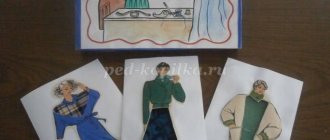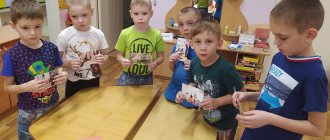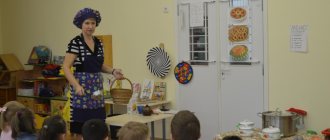Abstract of GCD on the topic “Household labor. "Helpers and Assistants"
MADOU CRR “Kindergarten No. 152”, Perm
Abstract of educational activities for children 4-5 years old with intellectual disabilities Household work “Helpers and assistants”.
Completed by: Teacher Buzmakova Marina Sergeevna
Perm 2014 Household work “Helpers and assistants” Objectives: 1. To instill in children the desire to work, to receive satisfaction from the results of their work. 2. Teach children to notice disorder in clothes and eliminate it. 3. Form in children the practical actions that they need to put things in order (washing). 4. Learn to plan your practical actions when carrying out work assignments. 5. Teach children to interact with peers in the process of carrying out household tasks. 6.Cultivate a sense of pride in the results of your work.
The teacher and the children approach the dollhouse. The room is decorated with balloons and there are treats on the table. The dolls are sitting in damp, soiled dresses. Educator: Guys, today is Natasha’s doll’s birthday. She invited her friends, but everyone is upset... Doll Masha accidentally spilled tea! What to do? How to cheer everyone up? (showing soiled clothes). Do you think we can help the dolls? How? (children's answers) That's right, we can wash dirty clothes. We will quickly fix the problem, wash all the clothes! But doing laundry, guys, is not an easy job. First we'll put on our aprons. Each of you has an apron on your chair. Get dressed, help each other get dressed, I’ll help someone. Why do you think aprons are needed (children's answers). Right, so as not to get dirty or wet clothes. Then the teacher turns to the doll: Oh, Tanya, what have you done! You can’t move around at the table, remember, it will come in handy! How should you behave at the table? (children’s answers). Before you and I wash, we need to undress our dolls (undressing table). We put dirty clothes in a basket. Let's take clean dresses from the locker and put on our dolls. Let's sit them on the sofa, let them watch how we work. Before we get started, let’s repeat what we need for washing. Showing diagrams: 1. Water, 2. basin, 3 ladle, 4. Dress, 5. Soap, 6. Clothespins. Now we are preparing our workplace (pay attention to the diagram, the teacher is helping). Educator: I will show you how we begin the work (due to the specific development of children, it is obligatory to show and pronounce your actions). First we wet our clothes. We put it in the water, look, the dress is wet. I place the dress in my palm, take a bar of soap, lather it, put the soap in the soap dish, and then start washing. Then squeeze it out. The dress has been washed, but it still needs to be rinsed so that there is no soap left. Pour out the water and rinse the basin. Pour it clean. Rinsing. Rinse cleanly, cleanly, so that the laundry is fragrant! We squeeze it out. We pour the water out of the basin and rinse. We put clean clothes, take clothespins, shake them and hang the clothes to dry. Then, when the clothes are dry, we iron them. Children perform all actions. Our motto: “Ready to work, more action, less words!” Let's get to work (let the children act independently, but help if necessary). Pronunciation by children: Soap is foaming in the washtub, We are washing, look! Don't disturb us now, our laundry is urgent! After the work has been done, a mandatory summing up is required. Well done, you did a good job!!! Do you help mothers at home? (children's answers). Appeal to the doll: Natasha is very happy, the holiday is not spoiled. She's here for all of us on our birthdays. Our holiday is not spoiled! You are a TOP CLASS team! (Treat for children)
Literature: 1.E.A.Ekzhanova.
E.A. Strebeleva. Correctional and developmental training and education. M. “Prosveshcheniye”, 2005. 2. Education of preschool children at work. Edited by V.G. Nechaeva. - M., 1983. 3. Moral and labor education in kindergarten. Edited by R.S.Bure.-M., 1987. 4.Internet resources. Full text of the material Abstract of the GCD on the topic “Household labor.
“Helpers and Assistants”, see the downloadable file . The page contains a fragment.
| Author: Buzmakova Marina Sergeevna → Gisich 03/24/2014 0 11475 463 | Comment |
Thank you for your mark. If you want your name to be known to the author, log in to the site as a user and click Thank you again. Your name will appear on this page.
Login | Registration
Have an opinion? Leave a comment
Summary of educational activities for mathematical development “Mom’s Helpers”
Program objectives: OO "Cognition" - consolidate the sequence of days of the week, exercise in determining the volume of liquid and measuring solids using a conventional measure (measuring vessel), develop the ability to identify and classify the properties and characteristics of objects, develop graphic skills, develop coordination of hand movements limited plane. OO "Socialization" - development of the desire to communicate and interact with peers, the ability to negotiate, fostering a sensitive attitude towards mother and a desire to take care of loved ones. OO "Communication" - development of communication abilities during collective activities, organizing the actions of another person with the help of speech, the ability to perform actions based on independent speech planning.
UUD - the ability to focus on a system of rules, the ability to listen and act according to verbal instructions, use sign-symbolic means, evaluate the correctness of one’s own actions).
Equipment and materials: invitation card, container with cereal, napkins, cup of water, saucepan, measuring vessel, counting sticks, colored Cuisenaire counting sticks, 3 boxes, geometric shapes circle, square, triangle, phonogram “Barbarika” “Far from Mom” , a basket with objects of different geometric shapes, checkered sheets according to the number of children, simple pencils, erasers, sheets with codes (symbols for creating an image), a graphic image of a flower, plasticine, paints, colored paper.
Preliminary work: looking at albums with family photographs, illustrations depicting mothers’ professions and household chores, memorizing poems for the holiday.
Progress of the lesson:
1. Motivational and orientation stage
The teacher finds an envelope on the table.
- Guys, look, what is this? Some kind of envelope, I wonder what’s in there, let’s take a look.
The teacher reads the contents of the invitation:
— Dear guys of the Ryabinka group, we invite you to the celebration, which will take place on Thursday, November 21 at 16:30.
- What day of the week is it today? (Thursday)
- What holiday are we invited to, do you know? (mother's day)
- Yes, today we congratulate the dearest and best mothers in the world. All week we talked about our caring, affectionate mothers, who look after us and protect us, and prepared to congratulate our mothers. Yesterday, for example, what day of the week was it? (Wednesday)
- What did we draw? (mom's portrait)
2. Search stage - Tell me, how else can you please and congratulate your mothers? (attention, care, gifts, song, poem)
— Do you think it’s easy for mothers to take care of the whole family, do they get tired? (Yes)
- How can I help my mother? What kind of work can you do together with your mother? (cook, wash, put things in order)
- Let's help our mothers make sure that you not only want to help them, but also know how to do it. For example, can you help me cook porridge for breakfast in the morning? (Yes)
3. Practical stage - Look what we have on the table. (millet cereal, water)
— According to the recipe, for one scoop of cereal there is one scoop of water. How can you find out, using objects lying on the table, how much water you need to add to the cereal in order to cook the porridge correctly? Let's think about how this can be done. (you need to count how many scoops of cereal are in a cup, then we’ll find out how many scoops of water you need to add)
- Tell me, when we measure using standards, what rule do we follow? (-there should be one measure; -we mark each measure with an object so as not to get lost when counting the measures)
- We will mark with counting sticks. One of you will fill the measures with cereal, and the other with water, the rest count and take turns placing counting sticks.
Performed by placing chopsticks near the cereal and water.
- Let's see how much cereal we got? (6 measures) - Find a stick that represents the number 6 (purple) - How much water? (also 6 measures) - Indicate the number of measures with a stick (6 - also purple) - What can we say about cereals and water? (the same amount of cereal as water, the number of measures is the same) - Did you calculate the proportions correctly? (correct) - The porridge will turn out great! - Guys, you said that you can help mom clean up the mess. What does it mean to put things in order? (put all things in their places carefully) - Let's see how you can independently and quickly put things in order.
Dynamic pause “Let’s get things in order”
— There are various things in the basket that need to be put in their places. You take turns picking up items and running towards three boxes. Here you need to decide which of these boxes to put the item in. To do this, you need to look into the boxes and find a common feature between the item in your hands and what is in the boxes.
They do it. Barbarika's song “Far from Mom” is playing
- Let's see if everything is in its place.
Let's check.
- Well done, you can bring order to the house! - What else can we please mom with? What can we do with our own hands? (present)
— Do you want to know what gift we will make for mothers? (yes)—You will receive an image of the gift by fax. Let's split into 2 teams. One team receives the digital image code and sends it to the other team by fax (Appendix 2). The task of the other team is to correctly receive the fax: decipher the code message (digital cipher) and receive an image. If the code is decrypted, the fax beeps.
The teacher shows the sign “We are ready” (Appendix 1)
— In order to quickly receive a fax, we’ll do a warm-up for our fingers – our assistants.
Finger gymnastics “Helpers”
Once upon a time there lived in a house (children clench and unclench their fists) Little gnomes: Toki, Peaky, Faces, Chicky, Mickey. (with the right hand they bend the fingers on the left hand, starting with the thumb) One, two, three, four, five, (with the right hand they bend the fingers on the left hand, starting with the thumb) The gnomes began to wash (rubbing their fists against each other) Toki - shirts , Peaks - handkerchiefs, Liki - pants, Chicky - socks, (the fingers on the left hand are bent again, starting with the big one) Mickey was smart, he carried water for everyone.
- Get ready, pay attention, the first fax is starting...
Graphic dictation “Flower”
Children of one group take turns reading the code, another group of children decode the code and build a corresponding image using the cells.
— Has the image been received? What is this? (flower)—Let's compare the original and the resulting image.
A sample image is displayed on the board, children compare the original and the resulting image (Appendix 3)
- Well done! What do you guys think, now your mothers can be sure that attentive, kind and sensitive children are growing up in their family - real helpers? (Yes)
- What convinced them of this? (children list completed tasks and activity results)
— Tell me, how can I decorate a flower? (plasticine, paints, colored paper)
Children choose the material at will and decorate the image of the flower in free artistic activity.
Annex 1
Appendix 2
Appendix 3
Author: Yulia Olegovna Vlasova, teacher, MKDOU No. 12 “Solnyshko”, Shelekhov, Irkutsk region, Russia
The article is published in the author's edition




